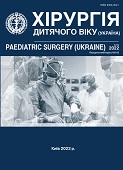Experience in the treatment of neonatal colie-klebsiellosis sepsis complicated by soft tissue necrosis of the scalp
DOI:
https://doi.org/10.15574/PS.2022.75.96Keywords:
newborn, intrauterine sepsis, wound sepsis, colie-klebsiellosis sepsis, necrosis, examinationAbstract
According to the modern epidemiology of sepsis, early newborn sepsis is bacterial in 84% of cases. According to the materials of the last congresses of the International Sepsis Forum (ISF), and in particular ISF 2021, among severe forms of neonatal sepsis, colie and klebsiella sepsis, closely associated with intrauterine maternal infection, prevail.
Purpose - to show efficiency of the pathogenic approach in the treatment of early newborn sepsis.
The article presents the experience of treating a newborn child with early newborn sepsis caused by intrauterine colie infection and associated with klebsiella infection, which was complicated by necrosis of the skin and fiber of almost the entire surface of the scalp.
The child was admitted to the newborn surgery department with signs of wound sepsis, an open infected wound covered with a necrotic soft tissue - hairy skin flap.
The studied prenatal history demonstrated a close relationship of the disease with intrauterine coliе infection. The child was examined by laboratory (microbiological blood and wound surface, biochemical - total, procalcitonin, C-reactive protein, coagulogram and also immunological (T-, B-lymphocytes, CD-64-blood) and instrumental (ultrasound, computed tomography, X-ray) methods.
On the basis of the obtained research results, pathogenetic therapy was carried out, the child was prepared for surgical intervention - necrectomy and subsequent transplantation of auto skin to close the soft tissue defect of the cranial vault.
As a result of the treatment carried out by a multifunctional team of doctors, the child recovered, the skin of the cranial vault of the head was completely restored.
Conclusions. The obtained research results and good treatment results demonstrated the effectiveness of the pathogenetic approach to the treatment of severe forms of neonatal sepsis.
The research was carried out in accordance with the principles of the Declaration of Helsinki on Human Rights. The research protocol is approved by the Local Ethics Committee of all participating institutions.
The consent of the child’s parents was obtained for the research.
No conflict of interests was declared by the authors.
References
Rudd K. (2021). Sepsis Epidemiology: Do WE Understand the Size of the Problem? Pittsburg University. USA. Report of Virtual Congress ISF.
Suchart Booraphun et al. (2021). Effectiveness of a sepsis program in a recourse-limited settingea retrospective analysis of data of a prospective observational study (Ubon-sepsis). Report of Virtual Congress ISF. https://doi.org/10.1136/bmjopen-2020-041022; PMid:33602702 PMCid:PMC7896572
Suresh G, Pammi M. (2019). Managment of the Late-Preterm and term Neonates at Risk for Early-onset sepsis. Hospital Pediatrics. 9 (4): 311-313. https://doi.org/10.1542/hpeds.2019-0005; PMid:30833295
Volosovez OP, Krivopustov SP. (2006). Etiology, pathogenesis, diagnosis, treatment and prevention of neonatal sepsis. Health of child: 1.
Downloads
Published
Issue
Section
License
Copyright (c) 2022 Paediatric Surgery (Ukraine)

This work is licensed under a Creative Commons Attribution-NonCommercial 4.0 International License.
The policy of the Journal “PAEDIATRIC SURGERY. UKRAINE” is compatible with the vast majority of funders' of open access and self-archiving policies. The journal provides immediate open access route being convinced that everyone – not only scientists - can benefit from research results, and publishes articles exclusively under open access distribution, with a Creative Commons Attribution-Noncommercial 4.0 international license(СС BY-NC).
Authors transfer the copyright to the Journal “PAEDIATRIC SURGERY.UKRAINE” when the manuscript is accepted for publication. Authors declare that this manuscript has not been published nor is under simultaneous consideration for publication elsewhere. After publication, the articles become freely available on-line to the public.
Readers have the right to use, distribute, and reproduce articles in any medium, provided the articles and the journal are properly cited.
The use of published materials for commercial purposes is strongly prohibited.

